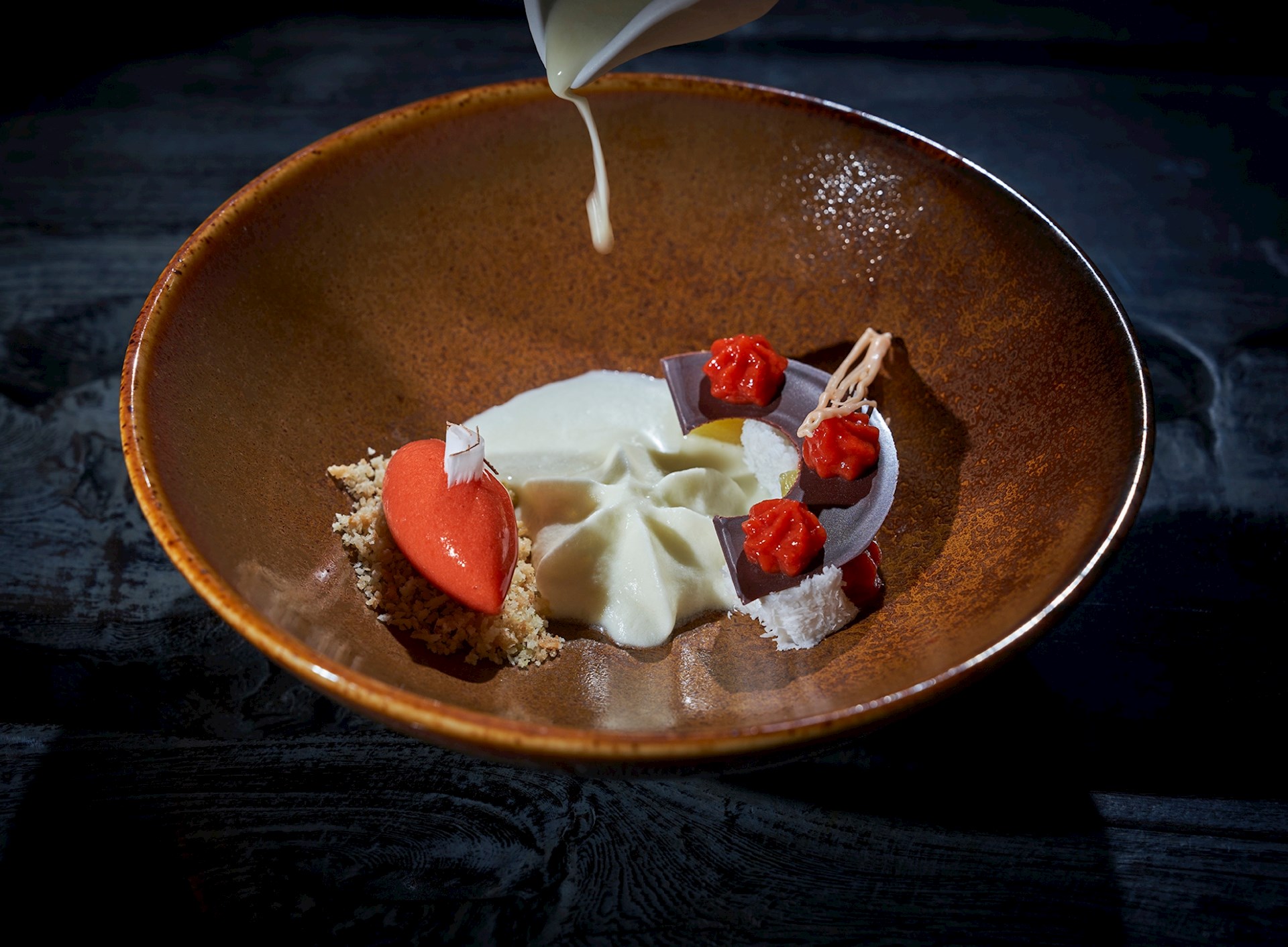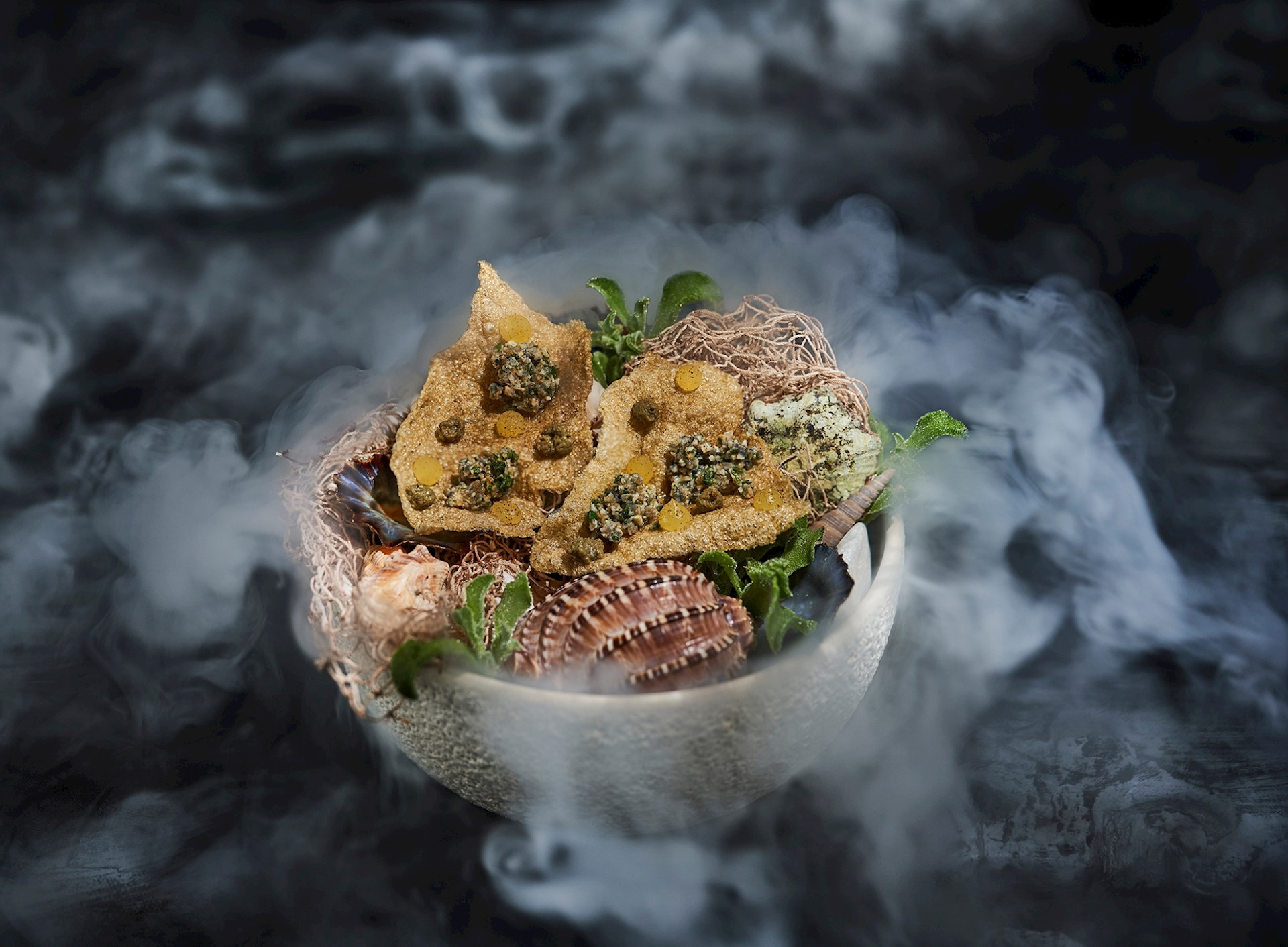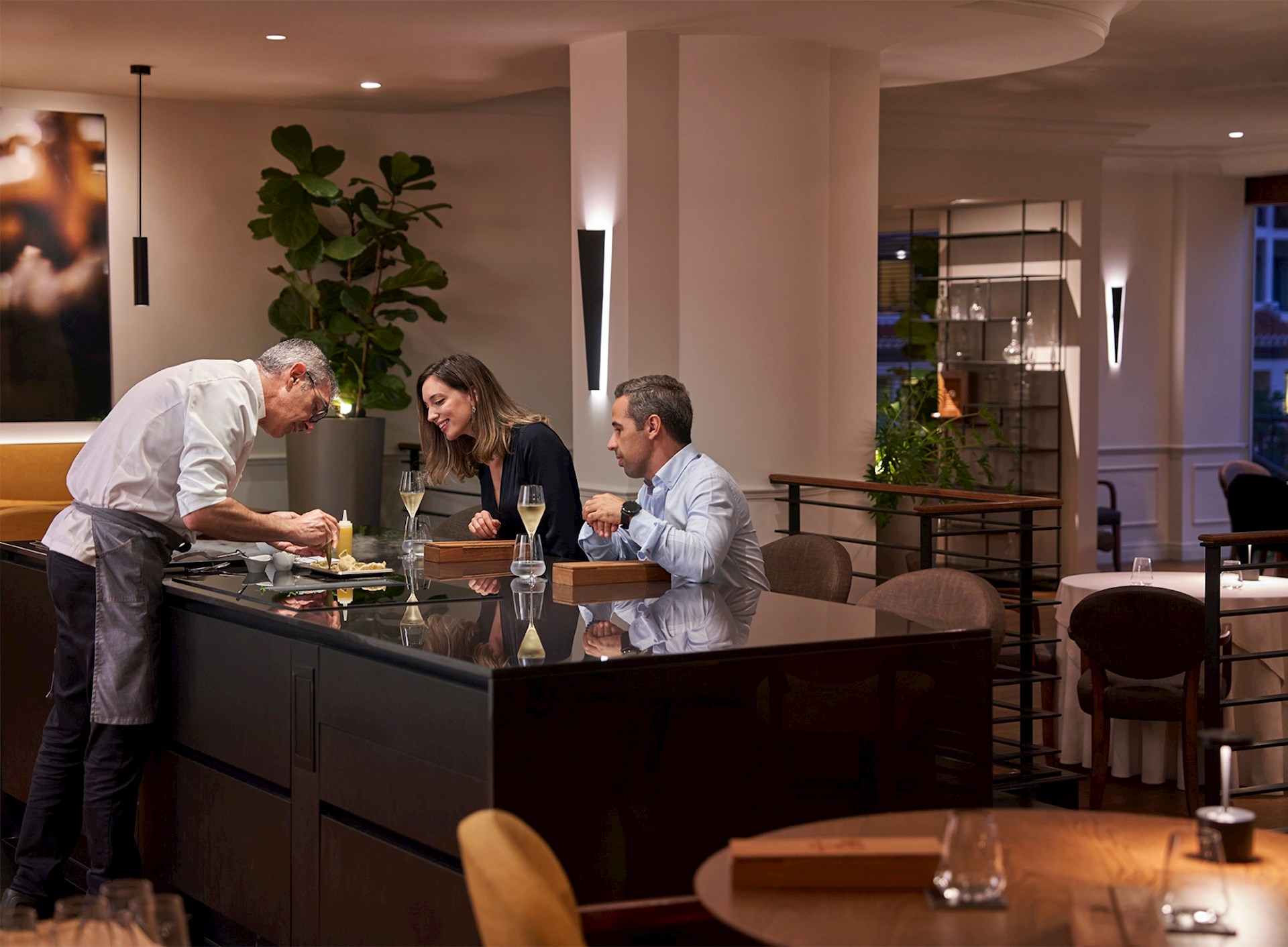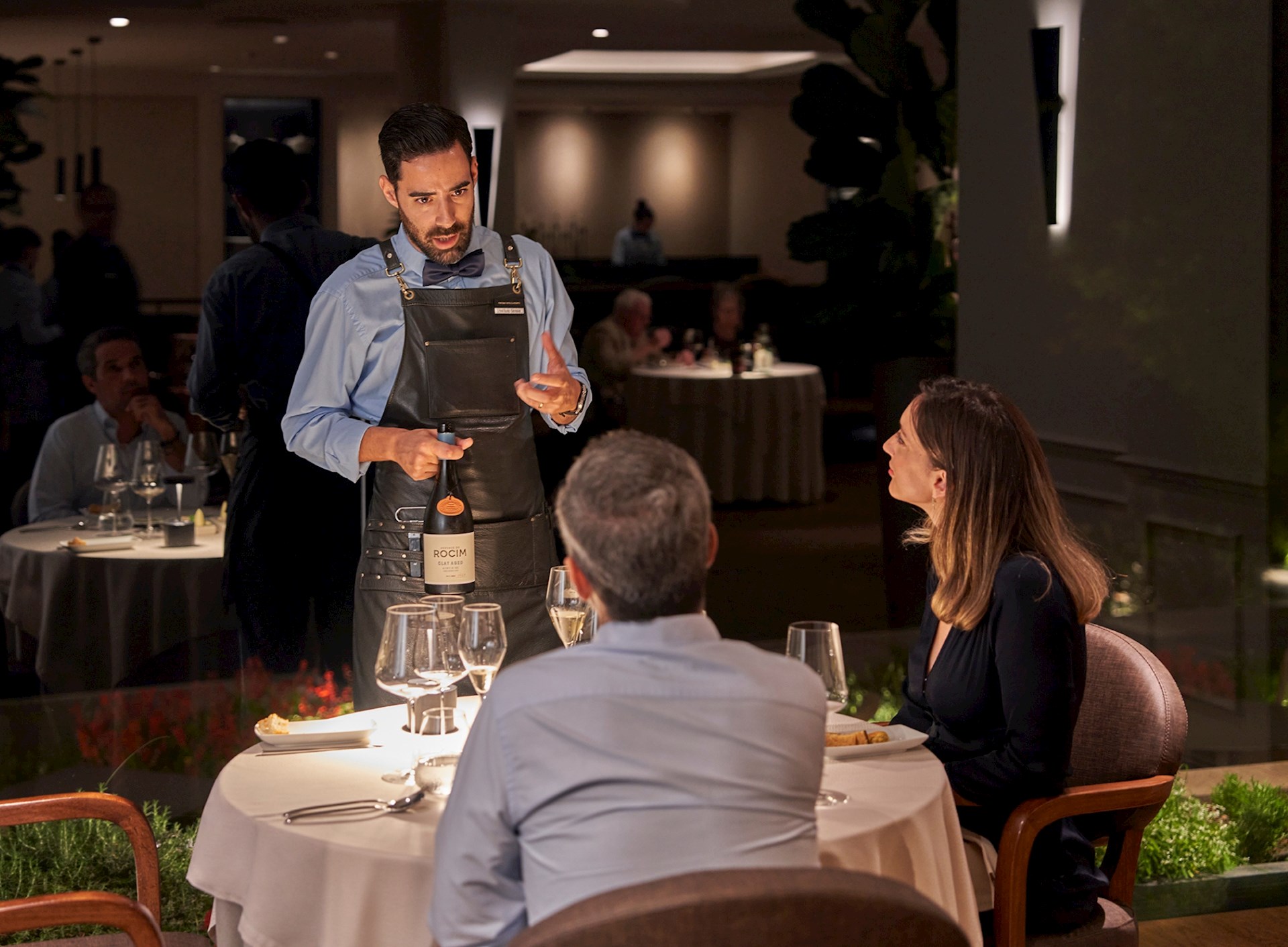THE STARS ARE SHINING AT IL GALLO D'ORO
A journey through colour, taste and sensations. A complete journey on a memorable night.
It all starts with a smile. This is how the hostess welcomes customers at the entrance to Il Gallo d'Oro and leads them to the table. Golden evening light enters through the huge glass walls. The sea provides the backdrop, reminding us that we are in Madeira.
In the dining room, a soft light picks out each of the unlaid tables on which, throughout the evening, utensils and culinary creations will be placed, as if during the different acts of a play. All of these are brought by the dining staff, who pay close attention to detail, and each table has its own dedicated team member.
Il Gallo d'Oro won its first Michelin star in 2009. It was the first in Madeira. Unprecedented. The second followed in 2017, and then a green star. All of this was under the leadership of Chef Benoît Sinthon, whose team brings the colour and aroma to the haute cuisine.
The team proves that the seasons are not just experienced in the outside world. They bring the tones of each season, like Spring, to the dish and the service. From the PortoBay garden come peas, broad beans, asparagus and artichokes. In the spring, mackerel, triggerfish, limpets, scabbardfish and above all tuna appear from the sea. The vegetable garden is increasingly important, ‘getting stronger and stronger’, says Chef Benoît Sinthon. And he gives the example of the new menu, which ‘in addition to having carrots and beets, now has onions’. The dish is called The One and Only and it revolves around onion, with chives, shallots and crunchy onion.
Il Gallo d'Oro continues to offer two menus: Top Experience and Terroir, which are adjusted regularly. Vegetables are an important component on both and this is more and more of a feature. The garden also provides fruits, which are used in pastries, such as pitanga, banana and tamarillo.

Sustainability is the rule. It is no coincidence that the restaurant was awarded a green Michelin star for its sustainability in the kitchen. This restaurant prioritises a short travelling distance for the food, in other words, local production. As far as possible, explains Benoît Sinthon, the fish used originates from the seas off Madeira: ‘desserts are made with fruit from the island, passion fruit, banana and tamarillo from the garden (locally known as English tomato), pitanga and American grapes from the garden, cherry from Jardim da Serra, and cider from Camacha’. There is Madeira wine and cream cheese, among various other products.
In addition, all products are used in the most balanced way possible. Between the PortoBay garden and Madeira as a whole, Madeiran products may represent between 35 and 55 percent of what is served, which is a sign of sustainability.
Madeira products are a constant, otherwise Benoît Sinthon wouldn’t be one of the pioneers in the current wave of new Madeiran cuisine. Some Madeiran corn porridge, baked here in the oven, is served on a dish of triggerfish with an exotic crustacean sauce, kaffir lime and cardamom.
The same mix between local and exotic can be found in the local limpets, served with a cracker, a marinade, a purée and a powder, and the Madeira couscous, served with a Chinese chow mein sauce.

Or the sweet potato incorporated into the Madeiran bolo-do-caco flatbread, offered every night as part of the bread service, which comes with other varieties, all made locally. Or a honey cake served as a crumble, in a tamarillo-based dessert.
But Il Gallo d'Oro is not a Madeiran restaurant. It showcases Madeira to the world. That is why there is a pigeon that comes from France, served with a eucalyptus aroma; foie gras with yuzu pineapple and honey cake crumble; or Portuguese lobster with cannelloni, avocado and gazpacho pearls.
The menus are balanced, a mixture of colours, aroma and flavour, flavour, flavour. This word could be combined a thousand times, such is the number of surprises on the palate that these creations provide.
But Benoît Sinthon recognises that customers like light but long menus, to try a little of everything, but to try everything.
The Chef's Table occupies a higher level, at a prominent position in the room. It works by reservation only. When two customers, Benoît Sinthon and two members of the team sit there, it makes for a different evening. At food festivals, the table is an epicentre of activity.

Currently, Il Gallo d'Oro regularly hosts Duetos. This is an invitation from Benoît to other chefs ‘who have an already established culinary repertoire, with character, terroir and stars and who may also have a green star. They are Chefs with the same or different techniques, depending on what I want at any given moment. They are new chefs, who are doing an excellent job’, he explains. The result is a two-handed tasting menu. ‘This motivates me to share my kitchen with the team and it is so important to share knowledge with the team,’ says Benoît Sinthon.
The entire dinner is dedicated to details. Like the customer's choice of knives to cut the suckling pig, or the cheeses, transformed into one of the high moments of the meal. Another detail is when the chef works the room, introducing himself to customers and finishing off one or other dish, to which he adds explanations. Benoît Sinthon is always performing. He never assumes that his customers know him, even though many know who he is.
Most of these details are provided by the sommelier, others by the stars of the evening. This is not only because of Leonel Nunes' natural talent, but also because he was elected sommelier of the year 2024, the first time that the Michelin Portugal Guide included this category.
Leonel welcomes customers with a glass of champagne, but the brand and type vary depending on the day, and whether it's hot or cold, sunny or raining.
Pairing throughout the meal is the liquid complement to the tasting. And the sommelier chooses from more than 400 bottles in the restaurant's wine cellar; but he offers other options, in addition to the whites and reds from Portuguese regions. There is, for example, a Madeira cider, which accompanies a duo of black scabbardfish, also from Madeira; or artisanal Ginja, infused with rum and Madeira wine, which brings out the flavour of the cheeses, not to mention the fortified wine, a Madeira, for dessert.

The end of the evening, after tea or coffee, can include another touch by the sommelier down in the wine cellar, one of Leonel Nunes' work spaces. This is where he offers a taste of Madeira wines chosen from very special batches and where the petit fours can be enjoyed. This ending to the evening is normal for those who reserve the chef's table, but it is also available to other customers, to make the experience complete.
